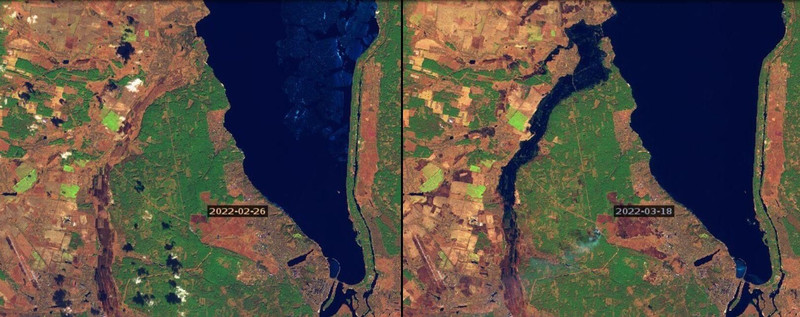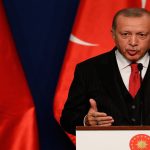In the early hours of 26 February 2022, Ukrainian air defences shot down a Russian missile reportedly heading for the Kyiv dam on the Dnieper River.
The hydropower reservoir behind the dam, which Russian forces had unsuccessfully attempted to seize on the first day of Putin’s invasion of Ukraine, stretches for 110km, covering an area two-thirds the size of London.
Had the dam been breached, 1.2 cubic kilometres of water would have been unleashed as a maelstrom of diluvian destruction, flooding the entire left bank of Kyiv city, potentially destroying other dams downstream, washing away bridges and threatening the Zaporizhzhya nuclear power plant.
Countless people would have drowned or been displaced from homes lost and large areas would have been left without electricity, water and transport.
A few days later, an auxiliary dam on the Kyiv reservoir was blasted apart. Satellite images reveal that the breach caused extensive flooding in the low-lying valley of Irpin River.
By mid-March, the water had reached houses in Demydiv village, the site of severe fighting as Putin’s forces sought to capture Kyiv. Both warring sides blamed each other for the blasting of the dam.
The tit-for-tat accusations reflect the use of water as a weapon by Ukraine as well as Russia.
One of the first actions that Russian forces took in the early days of the invasion was to blow up a dam on the North Crimean Canal in the Kherson region.
The dam had been built by Ukraine in 2014 to cut off water to Crimea, following Russia’s illegal annexation of the region. Russia has also accused Ukraine of releasing water from the Oskil reservoir to slow down any Russian advance to Donbas and of “preparing to blast” dams and dykes along the lower Dnieper, although such accusations may reflect Russia’s own intentions rather than realities on the ground.
Observers are increasingly concerned that the use of water as a weapon will escalate as the war continues, with devastating consequences.
In Mariupol, Russia has already cut water supplies as part of what the New York Times describes as a deliberate “tactic to try to starve the once-bustling city of 430,000 people into surrender”.
Water wars
The use of water as a weapon of war is not new.
It has long played a central role in siege and other warfare strategies. During War World II, as Nazi troops swept through Soviet-era Ukraine in August 1941, Josef Stalin’s secret police blew up a hydroelectric dam on the Dnieper River in the city of Zaporizhzhya to slow the enemy’s advance.
The explosion flooded villages along the banks of the Dnieper River, killing thousands of civilians and military personnel from both sides of the conflict. Estimates of human casualties vary from 5,000 to 100,000 people.
More recently, the weaponising of water has been widespread and systematic in conflicts in Syria and Iraq.
In 2015, ISIS blocked flows from the Euphrates dam in order to desiccate downstream areas. Conversely, near Fallujah, ISIS forces flooded areas to force out inhabitants and deflect attacks. And, south of Tikrit, ISIS deliberately contaminated water with crude oil. Other combatants have also weaponised water.
Syria and Turkey, too
In March 2017, the Pentagon bombed Syria’s largest dam on Euphrates, Tabqa. The disaster was only averted by workers at the dam’s hydropower plant risking their lives to prevent the dam from overflowing.
Turkey has also used water as a weapon in its long-running conflict with the Kurds.
Turkish-backed militia have deliberately cut off water supplies to the 500,000 people who live in North-East Syria. The problems have been exacerbated by dam-building and irrigation schemes in Turkey which have drastically reduced downstream flows to Syria and Iraq.
Based on their “first-hand experience of dealing with the devastating consequences of imperialist wars,” environmental and human rights groups working on water issues in the Tigris and Euphrates basins have urged all combatants in the Ukraine war not to target critical infrastructure.
In a statement expressing solidarity with the people of Ukraine and with Russians opposed to the war, the groups state: “We firmly believe that ‘hydraulic warfare’ in any form, along with targeting nuclear power plants, large oil facilities and gas pipelines, should be considered a war crime, regardless of the intentions of the warring side which is using it. Critical water and energy infrastructure should be off limit of military action”.
By NICHOLAS HILDYARD AND JOSH KLEMM
Source: EU Observer



